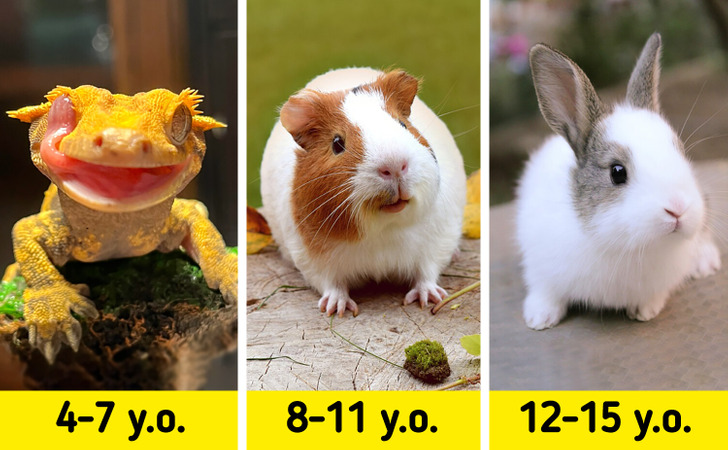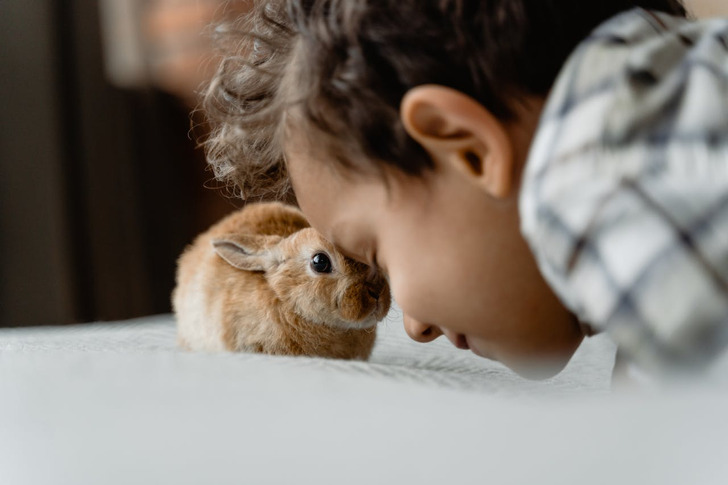
Getting a pet is like opening a door to a world of love, learning, and, yes, a little bit of mess. Pets for kids aren’t just cute companions — they teach responsibility, empathy, and the importance of caring for something other than themselves. Plus, they’re great at dishing out unconditional love.
But before you rush to the pet store, let’s talk about what it takes to pick the perfect family pet — and make sure everyone (yes, even the kids!) is ready for the responsibility.
Step One: Get the kids onboard

Dr. Laurie Hess, an exotic pet expert, explains that choosing the right pet for kids requires homework. “You have to be educated. Often people get frustrated and very disappointed in these animals because the experience isn’t what they expected,” she says.
If you don’t know what you’re getting into, that adorable animal might turn into a surprise you weren’t expecting — and not the good kind.
Dr. Elizabeth Mackey agrees, adding that the whole family has to be on the same page. Kids need to be genuinely excited about the pet and ready to help with pet care. And parents? If you’re not a fan of snakes, maybe don’t cave when your kid begs for a python.
Step Two: what to consider

Before you decide which child-friendly pet to bring home, think about these questions:
- How long will this pet live? Pets with long lifespans might outlast your kid’s college years.
- How much space do they need? Will they fit in your living room — or take over your entire backyard?
- What’s the daily workload? Can your family handle the feeding, cleaning, and vet visits?
- What about costs? Exotic pets, in particular, might need specialized care (and that can get pricey!).
- What does your child want? Are they looking for a cuddly buddy or something cool to watch from afar?
Once you’ve narrowed down your options, schedule a vet visit to get advice tailored to your potential pet. Meeting your family pet beforehand is also essential to ensure it’s the right fit.
Best pets for younger kids (ages 4-7)

- Parakeets
These chatty little birds are low-maintenance, affectionate, and can even learn to talk! They’re great for kids who are gentle and curious. Just remember: parakeets live a long time, so this is a commitment.

- Crested Geckos
If your family doesn’t mind lizards, a crested gecko is a soft, quirky pet for kids that’s perfect for little ones. They’re nocturnal, so they’re most active in the evenings, and they’re easy to care for — just be gentle, or they might drop their tail!
Best pets for middle-schoolers (ages 8-11)

- Rats
Rats are surprisingly sweet, smart, and affectionate. They bond with their owners, love to explore mazes, and can even learn tricks. Their short lifespan means they’re not around forever, so be prepared for that tough goodbye.

- Guinea Pigs
These cuddly critters are social and thrive with a buddy. They’re easy to care for, and kids can help with pet nutrition by feeding them veggies. Plus, they’re not as fragile as smaller animals, making them a solid choice for first-time pet owners.
Best pets for tweens and teens (ages 12-15)

- Rabbits
Rabbits are lovable and social but require more work than you’d expect. They need time out of their cage, careful handling, and lots of attention. If your teen is calm and patient, a bunny could be the perfect match.

- Bearded Dragons
These “beardies” are chill, handle-friendly reptiles that are great for older kids who want something unique. They need special lighting, proper pet nutrition, and a diet that includes live insects, so they’re a bit more advanced.
Long-term love: cats, dogs, and beyond

- Cats and dogs are the classic family pets for a reason — they’re loving, playful, and full of personality. But they’re also a big responsibility. Older kids can take charge of tasks like pet care, walking the dog, feeding, or even brushing their teeth.

- For something even more unique, consider a corn snake (gentle and easygoing) or a Greek tortoise (perfect for kids who love to observe). Just be ready for a long-term commitment — some of these pets for kids live decades!
Why cats and dogs might be a huge ’no’ for kids of any age

While cats and dogs are beloved family pets, they might not always be the best choice for kids of any age due to the substantial responsibilities they bring. These animals require significant time, energy, and financial investment, including daily feeding, grooming, vet visits, and training.
- Not all cats and dogs are universally kid-friendly — loud noises or rough handling from children can cause stress, leading to scratches or even bites.
- Pet allergies are another common concern, potentially causing discomfort or health risks for some children.
- Additionally, the cost of caring for these pets can add up quickly, with expenses for food, medical bills, and supplies creating a financial burden for families.
- Their long lifespans — dogs typically live 10-15 years, and cats even longer — mean that parents often inherit the responsibility when children grow up and leave home. Behavioral challenges such as barking, scratching, or destructive tendencies require patience and consistent training, which younger kids may not yet have the maturity to handle.
- Safety concerns are also a factor; even the friendliest pets can accidentally hurt small children. For busy families, lifestyle conflicts can leave these highly social pets feeling lonely or stressed.
- Moreover, kids may lose interest in their pets once the novelty wears off, leaving parents to take over the responsibilities.
For first-time pet owners, simpler, low-maintenance pets like guinea pigs or fish can offer a more practical alternative. These child-friendly pets can teach kids the basics of pet care without overwhelming the family, making them a great choice for families with young children or busy schedules.
Final Tip: It’s a family effort

At the end of the day, every pet needs love, care, and attention. If your child loses interest, it’s up to you to step in. Pets aren’t toys — they’re family members. So, choose wisely, prepare thoroughly, and get ready for a journey full of wagging tails, chirping tunes, or quiet, scaly companionship.
In the end, a happy family pet means a happy family — and lots of memories to cherish.
How pets benefit children’s development

Owning a pet isn’t just about companionship — it’s a powerful way to support a child’s behavioral and emotional growth. Research highlights that having a furry (or scaly) friend at home can help children develop essential life skills, empathy, and emotional resilience, making pets an invaluable part of family life.
- Enhanced Social Skills. Children with pets often exhibit stronger social interactions and greater empathy toward others. According to research, pet ownership has been linked to fewer peer conflicts and emotional challenges. This highlights the role of family pets in fostering social development and improving interpersonal relationships.
- Emotional Development. Interacting with pets during early childhood can significantly enhance a child’s ability to express and regulate emotions. A study reveals that toddlers with family pets were less likely to struggle with emotional expression later in life. Pets offer a non-judgmental and comforting presence, providing a safe space for children to explore and process their emotions.
- Responsibility and Empathy. Caring for a pet teaches children critical life skills such as responsibility and nurtures empathy. The research found that children who formed strong attachments to their pets were more likely to display empathetic behaviors toward others. This unique bond helps children develop compassion and a deeper understanding of how their actions affect others, both human and animal.
FAQs about family pets

- How can I prepare my home for a new pet?
Start by pet-proofing your home, buying the necessary supplies, and establishing a routine. Educate all family members about the pet’s specific needs and behaviors to ensure a smooth transition. - What are common health issues in family pets?
Health concerns vary by species but may include obesity, dental issues, and breed-specific conditions. Regular vet check-ups are essential for catching and preventing problems early. - How can I teach my child to care for a pet?
Involve children in daily tasks like feeding or cleaning, assign age-appropriate chores, and demonstrate proper care. This hands-on approach builds both responsibility and empathy. - What are the costs of owning a pet?
Expect expenses like food, vet care, grooming, and supplies. Emergency costs can arise too, so budgeting ahead is critical before welcoming a pet into your family. - What if someone in the family has pet allergies?
Consult a doctor, look into hypoallergenic breeds, and keep the home clean. In some cases, medications or lifestyle adjustments might be necessary to manage symptoms. - What should I consider when adopting a pet from a shelter?
Review the pet’s health, behavior, and background. Make sure you can meet its needs and provide a stable, loving home. Adoption counselors are great resources to guide your decision.
















:max_bytes(150000):strip_icc():focal(749x0:751x2):format(webp)/firefighters-recue-dog-that-fell-in-icy-pond-1-010226-2239db48a5894b2ca6ea50c805da048f.jpg?w=1200&resize=1200,0&ssl=1)
:max_bytes(150000):strip_icc():focal(749x0:751x2):format(webp)/Isabel-Klee-122225-43535fbd50104e9e8711da887b91ee58.jpg?w=1200&resize=1200,0&ssl=1)












:max_bytes(150000):strip_icc():focal(587x7:589x9)/hilary-duff-1-8885477a9c0e468782157a05b32cb221.jpg?w=1200&resize=1200,0&ssl=1)
:max_bytes(150000):strip_icc():focal(700x500:702x502)/Mickey-Rourke-TEATRO-Even-Summer-White-Affair-041425-01-dda588030a524ffb88242f46d853a6da.jpg?w=1200&resize=1200,0&ssl=1)





:max_bytes(150000):strip_icc():focal(722x378:724x380):format(webp)/farmington-hills-deliver-baby-040924-2-ffd1c156ebc647d6977e889eb9405d6f.jpg?w=1200&resize=1200,0&ssl=1)

:max_bytes(150000):strip_icc():focal(658x345:660x347):format(webp)/nacho-the-dog-tout-10212024-027bc33d675c4321b7d23a1c9b0d1188.jpg?w=1200&resize=1200,0&ssl=1)
:max_bytes(150000):strip_icc():focal(749x0:751x2):format(webp)/Noel-the-dog-090224-d33b921e95514585ab5564f64baf8397.jpg?w=1200&resize=1200,0&ssl=1)
:max_bytes(150000):strip_icc():focal(672x469:674x471)/cats-uhaul-7125-91f98aa63d0a41f4aa06508720df1702.jpg?w=1200&resize=1200,0&ssl=1)
:max_bytes(150000):strip_icc():focal(1125x315:1127x317):format(webp)/101-Dogs-Found-Crammed-in-Cages-in-Unassuming-NC-Home-060925-c0c6cbd2939948e88bb0942bc8a707fa.jpg?w=1200&resize=1200,0&ssl=1)